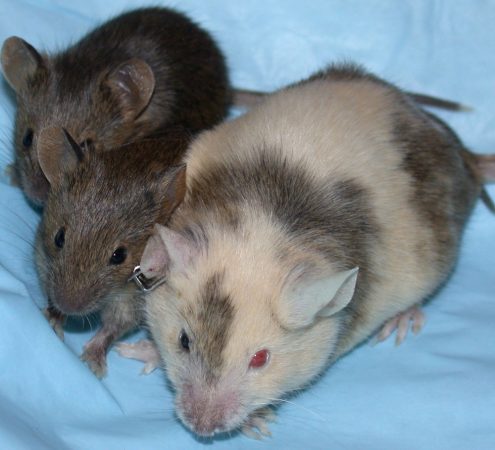Healthier mice, through X-rays
In sickly mice, small doses of radiation helped while vitamins harmed
Share this:
- Share via email (Opens in new window) Email
- Click to share on Facebook (Opens in new window) Facebook
- Click to share on X (Opens in new window) X
- Click to share on Pinterest (Opens in new window) Pinterest
- Click to share on Reddit (Opens in new window) Reddit
- Share to Google Classroom (Opens in new window) Google Classroom
- Click to print (Opens in new window) Print

If human health were a comic book, radiation would be a villain — and vitamins would be good guys. But in a recent study on laboratory mice, scientists got some topsy-turvy results. Low doses of radiation actually improved the health of animals born with a gene that can make them sick. And normally beneficial vitamins such as C and E undermined radiation’s benefits.
“Nobody wants to think that low-dose radiation could be advantageous and the stuff you put in your vitamin pill would be bad,” said Randy Jirtle of the University of Wisconsin–Madison. This is why Jirtle, who led the new study, was initially not excited about his new findings.
Radiation is the transmission of energy, as waves, through space. Examples include X-rays, microwaves and visible light. Some waves pass directly into living cells and can alter the genetic information inside. Such alterations can damage cells. In fact, it’s well known that high doses of some types of radiation can lead to diseases like cancer.
And that is why the new study’s results are surprising. Since high radiation causes big problems, scientists had expected low doses to cause small problems — or no problems. They never expected low doses could actually make a creature’s health better than no radiation exposure at all. The new results show that scientists still have a lot to understand about how the outside world affects our bodies.
“What goes on at high doses is not very predictive of what happens at low doses,” Edward Calabrese told Science News. Calabrese is a toxicologist — someone who studies the effects of potentially harmful substances or agents such as radiation — at the University of Massachusetts Amherst. He did not work on the new study. Some substances that act like poisons in large quantities may be helpful in small amounts, he notes. The new study’s result, he concludes, “is a major observation that is still to be appreciated.”
For their new tests, Jirtle and his collaborators worked with rodents called variable yellow agouti mice. From birth, these mice aren’t healthy. Their genetic material, or DNA, causes the rodents to have a strangely yellow coat and to more easily become sick. Jirtle and his collaborators treated pregnant mice with low doses of X-rays. Pups born to these mothers had browner coats. Since browner coats are normal and associated with other healthier traits in these animals, the scientists concluded that the small radiation dose made a difference — a surprisingly positive one.
The scientists suspect that the X-rays caused a change to the DNA that blocked the genetic condition that makes the pups sickly. That change was probably a type called epigenetic. In such changes, a molecule attaches to a gene, a sequence of DNA that contains instructions for building proteins. This attachment can alter the gene activity — in some instances stopping the gene from doing anything. Especially interesting, when Jirtle’s group gave vitamins to the mother mice, that molecule didn’t attach to the gene and turn it off in their offspring. Those baby mice, born with yellowish coats, did not have the epigenetic alteration.
So X-rays blocked the gene’s bad effect and vitamins prevented that beneficial blocking.
Jirtle cautions that the experiment showed its effect only on a particular type of sickly mouse. So the radiation treatment may not offer similar benefits to animals born without the harmful gene. However, Calabrese says the new study does suggest that low doses of X-rays may still hold some undiscovered benefits for human health.
Power Words
toxicology The branch of science concerned with the nature, effects and detection of poisons.
radiation The emission of energy as electromagnetic waves or as moving subatomic particles.
DNA The material present in nearly all living organisms; it carries genetic information.
gene A sequence of DNA that determines a particular characteristic in an organism. Genes are passed from parents to children, and genes contain the instructions for building proteins.
toxicology The branch of science concerned with the nature, effects and detection of poisons.
radiation The emission of energy as electromagnetic waves or as moving subatomic particles.
DNA The material present in nearly all living organisms; it carries genetic information.
gene A sequence of DNA that determines a particular characteristic in an organism. Genes are passed from parents to children, and genes contain the instructions for building proteins.







